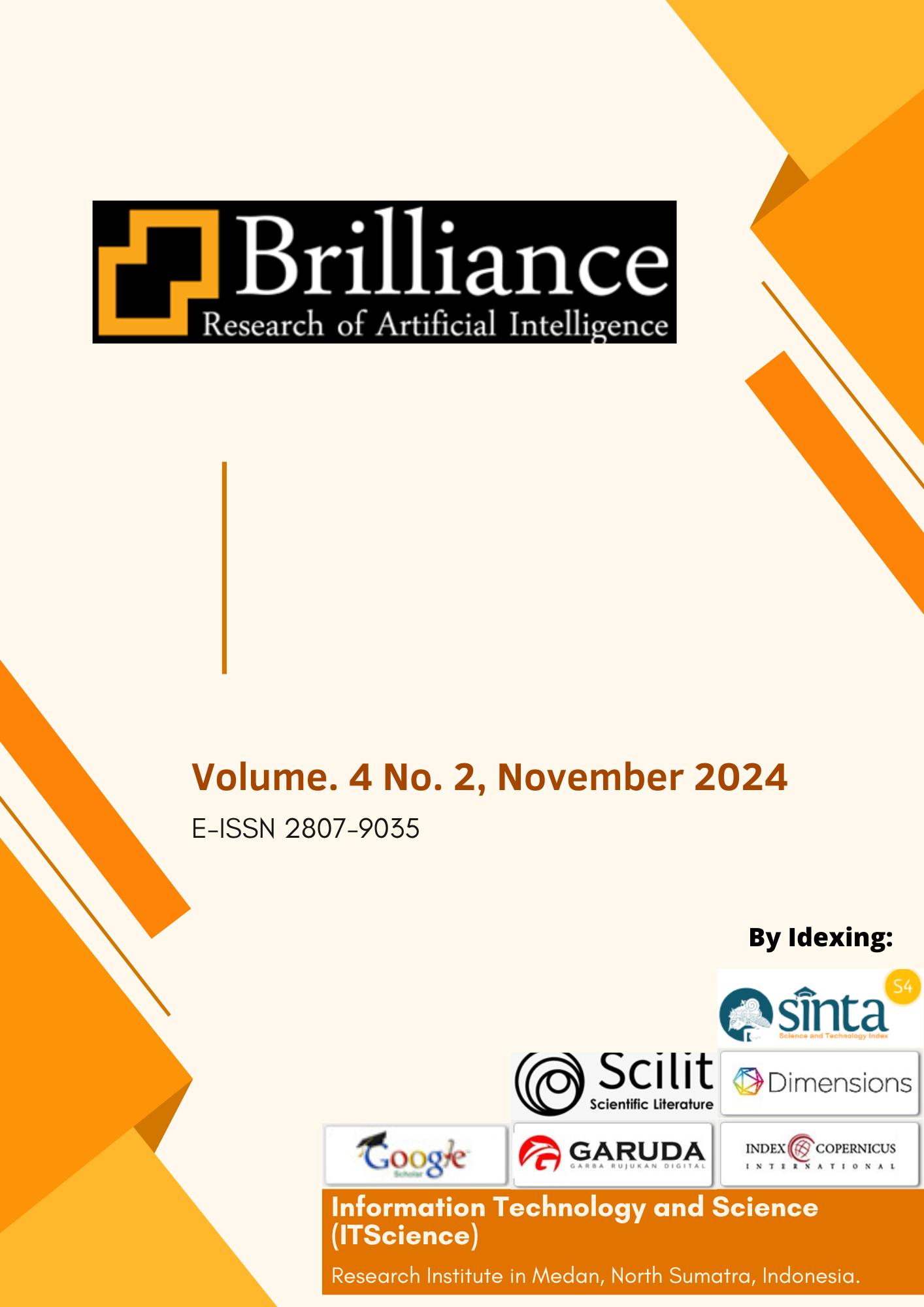Analysis of Public Opinion Sentiment towards the 2024 Presidential Election Based on Clustering Method with K-Means Algorithm
DOI:
10.47709/brilliance.v4i2.4821Kata Kunci:
Sentiment Analysis, Clustering Method, K-Means AlgorithmDimension Badge Record
Abstrak
The presence of social media, such as Twitter, Facebook and Instagram, provides a space for people to express their opinions freely and openly. Various sentiments, ranging from support to criticism of the candidates, work programs, and other political issues, have emerged along with the increasing public enthusiasm. Therefore, it is important to understand how public opinion is evolving and what is the main focus of public attention in the 2024 presidential election. The purpose of this research is to analyze the sentiment and views of the public about the presidential election using the Clustering approach and the K-Means method and to classify public opinion for various interests as well as optimizing social media information for the public interest. Based on the research conducted, the K-Means algorithm was successfully applied for sentiment analysis of public opinion on the 2024 presidential election, using tweet data taken through crawling Twitter as many as 220 tweets. From the dataset, 5 tweets were used for manual implementation of the K-Means algorithm calculation, through a series of pre-processing processes, including TF-IDF weighting. After the manual K-Means calculation, from 29 words generated from TF-IDF, the following clustering results were obtained: Cluster 0 (positive) contains 5 words, Cluster 1 (neutral) contains 18 words, and Cluster 2 (negative) contains 6 words. These results show that the K-Means algorithm can effectively cluster sentiment in public opinion data related to the 2024 presidential election based on patterns found in the words in the tweets.
Abstrak viewed = 8 times
Referensi
Abbas, M., Rioboo, R., Ben-Yelles, C. B., & Snook, C. F. (2021). Formal modeling and verification of UML Activity Diagrams (UAD) with FoCaLiZe. Journal of Systems Architecture, 114. https://doi.org/10.1016/j.sysarc.2020.101911
Al-Fedaghi, S. (2021). Validation: Conceptual versus Activity Diagram Approaches. International Journal of Advanced Computer Science and Applications, 12(6), 287–297. https://doi.org/10.14569/IJACSA.2021.0120632
Faesal, A., Muslim, A., Ruger, A. H., & Kusrini, K. (2020). Sentimen Analisis Terhadap Komentar Konsumen Terhadap Produk Penjualan Toko Online Menggunakan Metode K-Means. MATRIK?: Jurnal Manajemen, Teknik Informatika Dan Rekayasa Komputer, 19(2), 207–213. https://doi.org/10.30812/matrik.v19i2.640
Joergensen E Munthe, C., Astuti Hasibuan, N., & Hutabarat, H. (2022). Penerapan Algoritma Text Mining Dan TF-RF Dalam Menentukan Promo Produk Pada Marketplace. Resolusi?: Rekayasa Teknik Informatika Dan Informasi, 2(3), 110–115. https://doi.org/10.30865/resolusi.v2i3.309
Khan, M., Khan, S. S., & Alharbi, Y. (2020). Text Mining Challenges and Applications, A Comprehensive Review. International Journal of Computer Science and Network Security, 20(12), 138–148. http://paper.ijcsns.org/07_book/202012/20201215.pdf
Kurniawan, F. W., & Dr. Warih Maharani, S.T., M. T. (2022). Analisis Sentimen Twitter Bahasa Indonesia Menggunakan. 6(2), 7821–7829.
Makarychev, K., & Shan, L. (2022). Explainable k-means: don’t be greedy, plant bigger trees! Proceedings of the Annual ACM Symposium on Theory of Computing, 1629–1642. https://doi.org/10.1145/3519935.3520056
Melati, R., & Reza, M. (2024). Analisis Sentimen Data Twitter Menggunakan Metode K-Means Clustering Pada Studi Kasus Pemindahan Ibu Kota Nusantara (Ikn). Technology Acceptance Model) Jurnal TAM, 15(1), 66–73.
Mohammadi Sarab, M., Shahrokhi, M., & Tabatabaei, O. (2020). A Structured Approach for Display of the Most Practical Theories in ELT. Journal of Critical Studies in Language and Literature, 1(3), 36–55. https://doi.org/10.46809/jcsll.v1i3.27
M. Taufik Aufa, Jasmir, & Rohaini, E. (2024). Perancangan Sistem Informasi Pelayanan Pengaduan Masyarakat Kelurahan Bagan Pete Kota Jambi Berbasis Website. Jurnal Informatika Dan Rekayasa Komputer(JAKAKOM), 4(1), 937–945. https://doi.org/10.33998/jakakom.2024.4.1.1673
Nascimento, M. (2022). In Search of Star Clusters: An Introduction to the K-Means Algorithm. Journal of Humanistic Mathematics, 12(1), 243–255. https://doi.org/10.5642/jhummath.202201.19
Putri Yolanda, H., & Halim, U. (2020). Partisipasi Politik Online Generasi Z Pada Pemilihan Presiden Indonesia 2019. CoverAge: Journal of Strategic Communication, 10(2), 30–39.
https://doi.org/10.35814/coverage.v10i2.1381
Riyani, A., Zidny Naf’an #2, M., & Burhanuddin, A. (2019). Penerapan Cosine Similarity dan Pembobotan TF-IDF untuk Mendeteksi Kemiripan Dokumen. Jlk, 2(1), 23–27.
Rofiqi, M. A., Fauzan, A. C., Agustin, A. P., & Saputra, A. A. (2019). Implementasi Term-Frequency Inverse Document Frequency (TF-IDF) Untuk Mencari Relevansi Dokumen Berdasarkan Query. ILKOMNIKA: Journal of Computer Science and Applied Informatics, 1(2), 58–64. https://doi.org/10.28926/ilkomnika.v1i2.18
Rosaly, R., & Prasetyo, A. (2019). Pengertian Flowchart Beserta Fungsi dan Simbol-simbol Flowchart yang Paling Umum Digunakan. Https://Www.Nesabamedia.Com, 2, 2.
https://www.nesabamedia.com/pengertian-flowchart/https://www.nesabamedia.com/pengertian-flowchart/
##submission.downloads##
ARTICLE Diterbitkan HISTORY
Cara Mengutip
Terbitan
Bagian
Lisensi
Hak Cipta (c) 2024 Mhd Anshor Harahap, Muhammad Ikhsan

Artikel ini berlisensi Creative Commons Attribution-NonCommercial 4.0 International License.



















